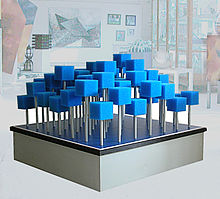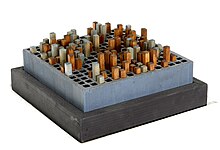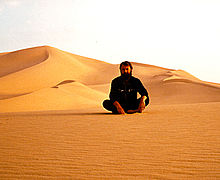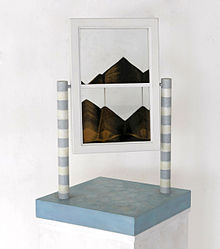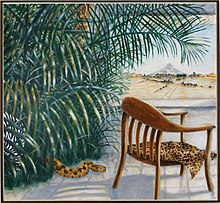Jox Reuss
Jox Reuss (born August 9, 1941 in Oberglogau , Upper Silesia ) is a German painter and sculptor . His artistic motto: “I have no intention of alienating reality. I want to realize the foreign ”.
Life
Hans Jürgen Reuss was born in Oberglogau, Upper Silesia. While fleeing from the approaching Soviet army, the family came to live with relatives in Nordhausen / Harz. During heavy air raids on Nordhausen on April 3 and 4, 1945, the boy was bombed several times, buried, traumatized and scared to death. With the bombed out inhabitants of the almost completely destroyed city, it was put into the tunnels of the underground facility of the Mittelbau Dora concentration campinstructed in Kohnstein. The further flight to the west led the family to Friedberg / Hessen. Jox Reuss grew up in Friedberg Castle, in the house of his uncle E. Robert Niederhoff, a teacher and writer. During his school days, he awakened his enthusiasm for the visual arts. 1959 studies at the Staatsbauschule Frankfurt, subject building construction and from 1961 studies at the State University of Fine Arts (Städel) in Frankfurt. First he was in Albert Burkart's class for painting (in which Hermann Goepfert also studied) and with Johannes Schreiter in the monumental painting class.
In 1961 he met Fritz Usinger in Friedberg Castle . For the young artist he was a sponsor, patron and collector and encouraged him in his artistic endeavors. In a dedication in 1977 Fritz Usinger wrote: "Jürgen Reuss, the co-creator of a new world."
Since 1964 Jox Reuss has been freelance with various studios in Bad Nauheim and since 1976 in Friedberg - Ockstadt . From 1976 expeditions through the Sahara led to Tunisia, Algeria, Niger, Mali, Mauritania, Senegal and Libya, among others. The colored sand brought by the tens was used in sand objects. The procurement of sand to expand the color range led him to the volcanoes of Europe (Stromboli, Vulkano, Etna, Vesuvius, Phlägrean fields). He had exhibitions in Germany, England, Belgium and France. In 2000 bronze medal for painting at the Autumn Salon of the Sociéte des Artistes Francais in the Grand Palais, Paris. Since 2004 he has been an Associate Member (MA) of the Société des Artistes Francais . In 2004, Jox Reuss received the Wetterau Culture Prize endowed with € 5000.
Artistic way
At the beginning of his artistic activity, Jox Reuss had little connection with the old-style panel painting. His works always moved between collages, material images and reliefs and finally stepped out into space to become plastic. So z. B. Sculptures like a 'ball made of balls', a 'ball made of balls', a 'cube made of cubes', 'stelae fields' and spherical fields, plate trees and iron bouquets. His sculptural works are based on the principle of 'grid' and 'grid' as a characteristic feature of the 20th and 21st centuries, as is the mass production of industrial parts. Jox Reuss incorporates these signs of the times in order to artistically and playfully overcome grids and grids in free forms. The parts from standardized production are put together to form new shapes in order to form a larger, individually shaped 'community'. He also understands this in a sociological sense.
Quote from Fritz Usinger: “Jox Reuss's artistic structures are concrete elements of their own, which do not depict or imitate the existing, concrete world, but rather want to enrich it with some new concrete elements. These thing-formations have no psychological reference to the artist who created them. You are there for yourself and lead a detached, separate existence. Hence the factual cheerfulness that is theirs. "
There is always something to turn, change, push and reshape in these spatial structures so that other people are actively involved.
In 1976 Jox Reuss took part in an expedition through the Ténéré in Niger. This encounter with the Sahara desert was decisive. The ability of the sand to transform itself in the dunes and to form again and again was fascinating for Jox Reuss and formed the core idea of the movable sand objects. In pictures and objects, the sand is used as a flowing color; by rotating it, painted surfaces are covered or exposed.
In the laudation for the award of the Wetterau Culture Prize, the journalist Hedwig Rohde said: “These sand pictures are perfect masterpieces and yet at the same time unfinished. Exact calculations, knowledge of the slope of the dunes, mathematical-physical laws, but also the so strongly felt fascination emanating from the desert as well as the playful effect, everything adds up, is concentrated on a few tens of square centimeters: the picture is a window out to a strange, constantly changing, changeable world, a world that can and should be changed. "
Moving and changing images and objects is also used on panel paintings and sculptures. Quotation from the opening speech of the exhibition 'Stranger Realities 2010' by art historian Andreas Ay: “Just as nothing stands still in nature and is subject to constant metamorphosis, dynamic change, so in Reuss art nothing stands still in the literal sense. ..... To think the areas of art and nature together and to be able to translate them into works of art requires, in addition to the agility of the mind, the courage to change. Painted panels and sculptures, with which the viewer can vary the shape and color areas at will, ensure dynamic changes in the color tone and the composition. "In the catalog for the exhibition WelTRAUMflug 2009 Friedhelm Häring writes :" In fact, Reuss is a "co-creator of a new one World “from a different reality .... The pleasant thing about the art of Jox Reuss is the search, the recognition, the contradiction, the doubt and the breaking open. From this his visions grow. Many of his models can be transferred to a larger scale and could change entire landscapes and cities. Big and small are not qualities. The art of Jox Reuss breaks the proportions, dream and world and flight prevent the fixation, the rigidity. His art is agile, moving. "
Exhibitions (solo exhibitions and participations)
- 1963 Albert Burkart and his students, Städel Frankfurt
- 1965 X in Aachen
- 1967, 1st Art Symposium, Bad Nauheim
- 1967 Galerie 66, Hofheim [solo exhibition (EA)]
- 1967 Neue Pforte student gallery, Aachen; (EA)
- 1968 Speeltijd-Plus in Bruges, Belgium
- 1968 sculpture in Hessen, Frankfurt
- 1968 Galerie Disque Rouge, Brussels, Belgium
- 1969 Galerie Plus-Kern, Ghent, Belgium
- 1974 Young art in Hessen, Frankfurt
- 1980 Carmelite Monastery, Frankfurt; (EA)
- 1981 guest artist at WDR with Jean Pütz
- 1981 Beck Gallery, Munich
- 1982 Kirchbaum Gallery, Königstein; (EA)
- 1982 Africa Gallery, Dornholzhausen; (EA)
- 1981 Margelik Gallery, Munich; Graphik-Berr, Munich
- 1983 Sand-Art, Bad Nauheim; (EA)
- 1985 with Beck in the Trump Tower, New York
- 1984 rural gallery, Taching; (EA)
- 1985 City Gallery Bruges-Oostkamp, Belgium; (EA)
- 1985 art + design, Hildesheim; (EA)
- 1986 Museum and Art Gallery, Buxton, England; (EA)
- 1986 Derbyshire Museums, England (EA)
- 1987 Weather Museum, Art Association Friedberg (EA)
- 1995 Old Library, Chaumont, France (EA)
- 1995 old train station, art circle Rosbach; (EA)
- 1996 Art in / on the barrel, Hattenheim; (EA)
- 1998 New Gallery, Bad Nauheim; (EA)
- Le Salon 2000, Paris (bronze medal)
- 2001 Eureka College du Futur, Troyes (EA)
- 2001 Festival of Contemporary Art, Calvi, Corsica
- 2002 Art Present Gallery, rue Quincampoix, Paris; (EA)
- 2009 Salon d'automne International, Lunéville, Nancy
- Culture Prize 2004, Kreishaus, Friedberg (EA)
- 2006 Kerckhoff Institute - reception hall, Bad Nauheim (EA)
- 2009 Upper Hessian Museum, Giessen (EA)
- 2010 Municipal Gallery Drinking Spa Bad Nauheim (EA)
- 2013 Foyer of the Badische Landesbibliothek, Karlsruhe
- 2014 Bad Nauheim Art Association
- Irregular participation in the 'Art en Capital' salons at the Grand Palais, Paris , from 2000 to the present day.
Awards
- Le Salon 2000, bronze medal (section peinture) Grand Palais Paris
- Wetterau Culture Prize 2004
Works in public space
- Plastic at the Friedberg town hall, Hesse
- Spherical sculpture at the Dortelweil kindergarten
- Plattenfeld at the Rockenberg kindergarten
- Wall design sand pictures in the BBW Südhessen
- Rotating wall relief in the Wilhelmskirche Bad Nauheim
- Wall design "Eurobject" in the Volksbank Mittelhessen, Goethestrasse, Giessen
- Jox Reuss "Sword and Shield" , near Limeshain-Rommelhausen
- "Little Marsfeld" in the Bad Nauheim spa gardens
- Jox Reuss " Ball Sun " on the Niddaradweg near Assenheim / Niddatal
Works in public collections
- Collection of modern art by Fritz Usinger
- In the weather museum, Friedberg
- Gemäldegalerie Oberhessisches Museum, Giessen
- Municipal collection, Bad Nauheim
- Art collection of the Wetteraukreis
Web links
Individual evidence
- ^ Fritz (PDF) Usinger as a collector
- ↑ Dedication (PDF) co-creator
- ↑ Bronze medal (PDF)
- ↑ Membre A. variabiles.de (PDF)
- ^ Gallery Peinture
- ↑ Wetterau Culture Prize 2004
- ↑ Dedication (PDF) Finder and Former
- ↑ quote
- ↑ sand objects
- ↑ Stranger (PDF) realities
- ↑ Catalog World Dream Flight (PDF)
- ↑ Albert Burkart
- ↑ dingdoing (PDF)
- ↑ Speelijd
- ^ Plastic (PDF) in Hessen
- ↑ Buxton (PDF)
- ↑ Desert (PDF) volcano
- ↑ Chaumont (PDF)
- ↑ Troyes (PDF)
- ↑ Calvi (PDF)
- ↑ Luneville (PDF)
- ↑ Culture Prize
- ↑ Kerckhoff (PDF)
- ↑ Giessen (PDF)
- ↑ Municipal (PDF) gallery
- ↑ Karlsruhe (PDF)
| personal data | |
|---|---|
| SURNAME | Reuss, Jox |
| ALTERNATIVE NAMES | Reuss, Hans Jürgen (real name) |
| BRIEF DESCRIPTION | German painter and sculptor |
| DATE OF BIRTH | August 9, 1941 |
| PLACE OF BIRTH | Oberglogau , Upper Silesia |

